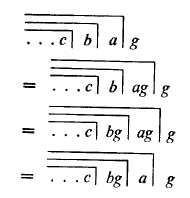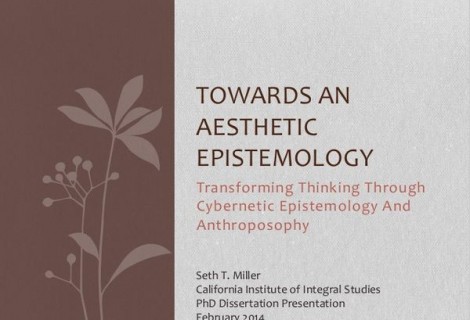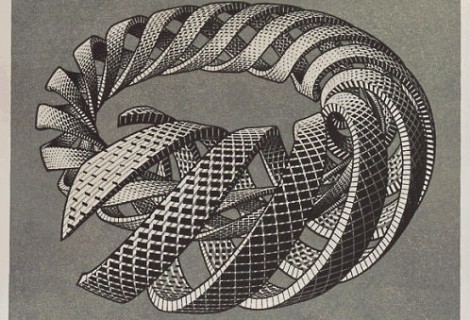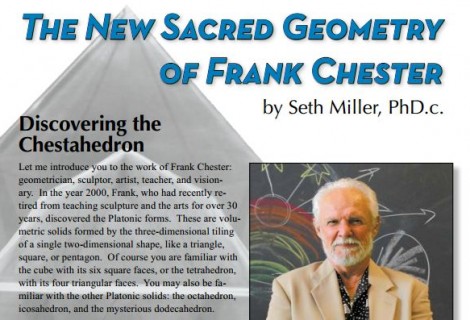An Esoteric Guide to Spencer Brown’s Laws of Form #4
« Previous Page | 1 2 3 4 | View All | Next Page »
(New readers will want to start with the first installment.)
We ended the last installment having come to realize something of the esoteric significance of the taijitu, or yin-yang, form, in something of an extended tangent. We return now to the text.
GSB himself seemed to understand the importance of the Laws of Form, even if there were some of these more subtle specifics which were not apparent to him (or at least which he did not explicitly recognize). Having reached this point (literally we are still on page 1 of LoF), the vast majority of the rest of the work in LoF is seen to be secondary. Yet there are many valuable indications which deserve connection to esoteric principles, and the point of this exploration is to show that such connections are not arbitrary. So, to return to the actual content of LoF now, after this long but foundational detour, we can note that he says:
LoF p. 5
- Let any token [of the mark] be intended as an instruction to cross the boundary of the first distinction.
That is, every mark is an invitation to cross it; every distinction is a call to make that distinction, not to simply point it out, but also to DO it, to MAKE the distinction. In other words, the whole thing is ACTIVE, not passive, it is not descriptive but PRESCRIPTIVE. Of course, the esoteric significance of this should be obvious, because precisely what distinguishes esoteric work from, say, philosophy or other disciplines, is that it is, at its roots, injunctive. That mathematics is the discipline most closely allied to esoteric work in this respect only serves to strengthen the indication that mathematics is the most spiritual of academic disciplines.
Now, if you don’t know, GSB uses LoF to show how, starting from one single form, he can build an entire logical calculus, including (but not limited to) the Boolean Algebra. In fact, the way he came upon the LoF was precisely through asking himself the question “what is the basic arithmetic upon which the Boolean Algebra is based?” (Esalen conference, session two).
He uses the token of the form, the upside-down and backwards “L” as an operator to do this work. The whole of the logical calculus in LoF is built out of the way that this form works with itself, and he notes that the two “primitive equations” upon which everything else is based take the form:
LoF p.11
He calls the first primitive equation number, and the second (where a form is inside itself, which equals the unmarked state) order. Why is this important? Because we can note that these two principles, upon which everything that is to follow in LoF is based, is nothing other than the embodiment, in form, of the principle of the N and N+1 orders discussed as the key to the whole thing in the first place.
To state it another way, these two primitive equations work because they embody exactly what would be required of them if they were to work (to take a GSB type of phrasing). More directly, they embody the principle of the creation of the cross and the crossing of the cross. Together, these two equations express the principles required to yield all the complexity necessary for any ontology: this means they have, together, a horizontal and vertical direction, or a breadth and depth, a distinguishing and a unifying nature. The first equation is horizontal: it serves to open up all the later logical space in LoF. The second equation is vertical: it serves to unify across levels, or to create more levels. You can see that this is just what is implied in the levels N and N+1: the level N is what it is by virtue of its containing everything else that is at level N, while the level N+1 is precisely the activity of the unification of everything in level N. N is the content, N+1 is the activity by which anything in N gets to be in N in the first place, vs. at any other level (say, N-1). The reason for calling these levels N and N+1, vs. actually counting them from some starting point should be obvious: they are recursive with each other; there can never be some absolute destination “N” that could serve to begin the counting. We can only ever count from where we actually begin.
It is worth pointing out that GSB, thankfully, is very clear that, even though his two primitive equations express equalities, the direction matters. To state it another way, this is another example of the importance of the distinction between N and N+1. At the level N we simply have the two equations, and one side simply is identical with the other. But whether you start from the left and move across the equal sign to the right or vice versa is significant. GSB even gave names to these differences: he calls them like this:
LoF p. 10
Keeping with the esoteric theme, we would note, based on our previous discussion, that these also all embody the “fifth essence”, the “C” of Glanville, the transfer function, the Cosmic Christ. So we have here two polarities, one of distinction (between number and order, which can be taken as GSB’s way of speaking about N and N+1), and one of direction (between condensation and confirmation, and between cancellation and compensation). The first polarity is, as we have seen, a vertical polarity; it is responsible for all hierarchy, and it is what was not explicit in Glanville’s works. The second polarity is a lateral polarity: it is responsible for the creation and dissolution of content for each hierarchical level.
Why is this worth pointing out? Because herein lies a formalization of a very deep esoteric principle, which is that everything that is, because it is, can transform. Remember, we are trying to speak here about the very source of all possible logic, so what we find in this realm should have serious implications for every actual logic, and therefore for every implementation of every actual logic. This is to say, the work here is looking towards the fundamentals of all epistemology. At the same time we are trying to speak about the very source of all possible form, for the existence of existence as such, regardless of its form. This is to say, the work is also looking towards the fundamentals of ontology. What is important, esoterically, is that we find out that at their roots, both epistemology and ontologymeet and unify in a complex, recursive way. Knowing and Being form a complex, recursive unity.
It is actually very clear to GSB that his work is meant explicitly to unite epistemology an ontology. He states that:
LoF p. 101
- Throughout the essay, we find no need of the concept of truth, apart from two avoidable appearances (true = open to proof) in the descriptive context. At no point, to say the least, is it a necessary inhabitant of the calculating forms. These forms are thus not only precursors of existence, they are also precursors of truth.
This provides an interesting (and transformative) perspective on the question of why it is that we can know anything, and also on what it is that is possible to know. The scope of these questions in their details is beyond the current exploration, but suffice it to say, embedded in these formal equations lies a secret to esoteric transformation: indicating both that it is possible, and also something about how it is possible. You may even, if you are keen, note that it tells you something specific about what it looks like to transform, and thus how to do it.
Now, later, GSB gets into some of these details. For example he shows that:
LoF p. 40
This is his Theorem 13. Taken esoterically, this principle is seen in how ontology+epistemology (as a unity) flows from higher levels to lower; i.e. all existence and knowledge is derivative (generative based on higher order principles). I.e. “As Above, So Below” (which is only half of the story).
Then we have his Theorem 14:
LoF p. 40
- From any given expression, an equivalent expression not more than two crosses deep can be derived.
Esoterically, ACTUAL knowledge can be traced back to higher order realms. That is, the indication of Theorem 13 can be actually carried out starting with ANY knowledge. In other words, because all knowing is derivative, it can lead back to its origins. But to discover this actually, for any particular knowing, we must, in the language of GSB, cross. Esoterically, of course, this is recognition of the principle that transformation is an activity, and one that can be cultivated. All of esoteric work is simply an elaboration of the injunction: cross. This adds the second half of the story missing above: “As Below, So Above”.
This has further consequences.
LoF p. 41
- From any given expression, an equivalent expression can be derived so as to contain not more than two appearances of any given variable.
This is GSB’s Theorem 15. Esoterically, this is the principle of the archetype: knowledge instantiates the activity of archetypes, and these archetypes are ALWAYS a unity, that unity being given by their form of distinction. Multiple instantiations of a given archetype in different areas of knowledge are not separated, but can always be seen as participating directly in that single archetype. This is to say that an archetype can never be distinct from itself. You can perhaps see how, from an esoteric point of view, this is implicated in the above discussion about hierarchy and transformation, and the relation between universal law and its expressions from the near the beginning of this exploration.
Moving on, GSB indicates that:
LoF p. 53
- The initials of the primary algebra are in dependent.
Remember the initials are the two equations we discussed above. The point is that these are not derivable from each other (or they would reduce to a single equation and thus not be “initial”). This means that all possible logics require a distinction of distinctions. This is to say that the form of any logic (its second order nature, N+1) requires its first act to be the realization of this form, which is its content (its first order nature N).
In other words, the foundation and generation of all logics is recursive, taking the form in which the second and first orders are mutually generative (i.e. the distinction of distinction). You may think that somehow this obviates the very principle of independence, because they are mutually generative. Not so, and this is the heart of the matter. It is precisely this type of recursion, between N and N+1, that maintains the distinction. They are mutually generative, not simply generative; this means that they require each other distinctly, in order for their own separation. They cannot be reduced to each other, and both are required. We have a complex unity, not a simple one.
Now, GSB gets into some fascinating territory with respect to “re-entry into the form”. He describes re-entry in this way:
LoF p. 56
- The key is to see that the crossed part of the expression at every even depth is identical with the whole expression, which can thus be regarded as re-entering its own inner space at any even depth.
We can see that he has just described the taijitu. What is important about GSB’s work is that it provides a way to stop the recursion at any given point, and to then look around to see what’s going on. This is to say, it can be used to calculate, to situate with directness towards one state (knowing that the states are infinitely transformable).
Most importantly, the necessity of re-entry (recursion), which we have seen lies even at the root of the root of GSB’s work (even though he didn’t point this out himself), leads him directly to something that was implicit in the form but which can be itself brought out in a calculable way. I am referring here to the generation of the imaginary realm (the home of imaginary numbers, which are found as necessary roots to the regular algebraic equation x^2 = -1).
What is important, esoterically, has to do with what GSB points out as the key feature of the imaginary numbers: they are oscillatory. Let me explain… next time.








